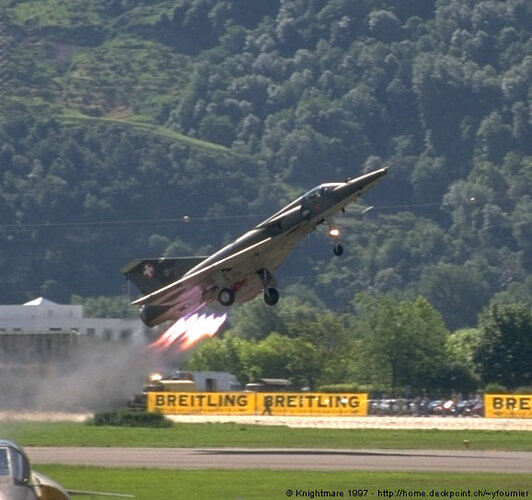I think the combination of pylon space and physical size of the various SARH BVR missiles might play a large part here. If you consider the Mirage III pretty much always needed its wing pylon fuel tank to provide an acceptable operational range this pretty much reduces you to using the centreline unless one does go the Swiss option of using something such as the HM-55/AIM-26B or even AIM-4E/F.
Assuming this, it might also be interesting to do a comparison between the various realistic options at the time the Mirage III was in main operational service (I'm talking about the mid '60s - mid '70s (note that I have only looked at SARH options:
Looking at this, one will see that whilst the AIM-7 might provide a better option, the Mirage III would probably still be limited to a single copy on the centreline. Likewise, the Swiss choice of the twin HM-55 probably does provide a good alternate option - I'm surprised more didn't consider the option - Sean can probably explain why (missile performance perhaps?).
EDIT: The only other option might be the AIM-9C SARH version. Perhaps a 'Soviet style' load out of 2 x IR AIM-9s and 2 x SARH AIM-9s could have been considered though using the below image of the Kfir as a guide, one would probably still be looking at giving up the external fuel tanks:

Assuming this, it might also be interesting to do a comparison between the various realistic options at the time the Mirage III was in main operational service (I'm talking about the mid '60s - mid '70s (note that I have only looked at SARH options:
R.530 | AIM-7E | AIM-4E | AIM-4F | HM-55/AIM-26B | AIM-9C | |
|---|---|---|---|---|---|---|
| Length: | 3.28 m | 3.66 m | 2.18 m | 2.19 m | 2.16 m | 2.87 m |
| Wingspan: | 1.1 m | 1.02 m | 0.61 m | 0.61 m | 0.62 m | 0.63 m |
| Diameter: | 0.263 m | 0.203 m | 0.16 m | 0.17 m | 0.29 m | 0.13 m |
| Weight: | 192 kg | 197 kg | 63.5 kg | 68.9 kg | 117.3 kg | 88 kg |
| Speed: | Mach 2.7 | Mach 4 | Mach 3 | Mach 3 | Mach 2 | Mach 2.5+ |
| Max Range: | 20 km | 30 km | 13.8 km | 13.8 km | 19 km | 18 km |
| Warhead: | 27 kg | 30 kg | 4.67 kg | 3.9 kg | 22 kg | 11 kg |
| Comment: | Realistically, would be limited to single copy on centreline | Potentially 2 carried | Potentially 2 carried | 2 carried as per Mirage IIIS | Potential for 2 x SARH + 2 x IR? |
Looking at this, one will see that whilst the AIM-7 might provide a better option, the Mirage III would probably still be limited to a single copy on the centreline. Likewise, the Swiss choice of the twin HM-55 probably does provide a good alternate option - I'm surprised more didn't consider the option - Sean can probably explain why (missile performance perhaps?).
EDIT: The only other option might be the AIM-9C SARH version. Perhaps a 'Soviet style' load out of 2 x IR AIM-9s and 2 x SARH AIM-9s could have been considered though using the below image of the Kfir as a guide, one would probably still be looking at giving up the external fuel tanks:
Last edited:









